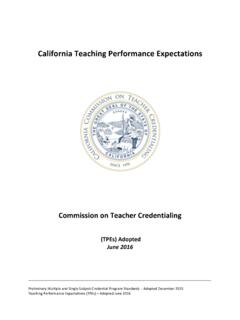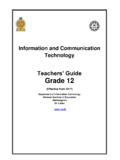Transcription of Physics S5 Teacher Guide - Rwanda Education Board
1 Physics . Teacher 'S Guide . FOR Rwanda SECONDARY SCHOOLS. S5. CONTENTS. ii - liv 1. Wave and Practical Nature of 1-22. Unit 1. Lesson development .. 4. Main contents and concepts to 14. Solution to Activities and 16. 2. Simple Harmonic 23-47. Unit 23. Lesson development .. 26. Main contents and concepts to 33. Solution to Activities and 35. 3. Forced Oscillations and Resonance of a 48-61. Unit 48. Lesson development .. 51. Main contents and concepts to 60. 4. Propagation of Mechanical 62-77. Unit 62. Lesson development .. 65. Main contents and concepts to 74. Solution to Activities and 75. 5. Complex Electrical 78-95. ii Unit 78. Lesson development .. 80. Main contents and concepts to 91. Solution to Activities and 92. 6. Fossil and Non-fossil Fuel and Power 96-111. Unit 96. Lesson development .. 99. Main contents and concepts to 110. 7.
2 Electric field potential and gravitational 112-127. Unit 122. Lesson development .. 115. Main contents and concepts to 124. Solution to Activities and 127. 8. Motion in 128-145. Unit 128. Lesson development .. 131. Main contents and concepts to 140. Solution to Activities and 143. 9. Atomic models and photoelectric 146-165. Unit 146. Lesson development .. 149. Main contents and concepts to 158. Solution to Activities and 161. iii 10. Analog and Digital 166-183. Unit 166. Lesson development .. 169. Main contents and concepts to 179. Solution to Activities and 182. 11. Mobile phone and radio 184-196. Unit 184. Lesson development .. 168. Main contents and concepts to 195. 12. Relativity concepts and postulates of special 197-210. Unit 197. Lesson development .. 200. Main contents and concepts to 208. Solution to Activities and 209. 13.
3 Interference of Light 211-225. Unit 211. Lesson development .. 214. Main contents and concepts to 222. 14. Stellar Distance and 226-240. Unit 226. Lesson development .. 228. Main contents and concepts to 238. Answers to end of unit 239. iv Introduction Physics AND SOCIETY. The purpose of this Teacher Guide is to help teachers to implement the Physics syllabus of senior five according to unit planning, lesson planning and lesson delivery to develop the learners' competences and skills. It is designed to stimulate teachers to create meaningful teaching programs and lessons by enabling them to choose relevant and purposeful activities and teaching activities. It will encourage teachers to research and look for new and challenging ways of fecilitating students' learning in Physics . The Teacher Guide supports the syllabus. The syllabus states the key unit competences to develop, links to other subjects, assessment criteria, learn- ing outcomes for the subject and units, and outlines the content and skills that students will learn.
4 Rationale of teaching and learning Physics Physics AND SOCIETY. Physics is one of the natural science subjects and contributes significantly to global socioeconomic transformation through its discoveries. These have led to development of new technologies in all fields of production and are beneficial to mankind. Applications of Physics knowledge is evident in industries, engineering, transportation (automobiles, trains, flights etc), medicine and Information and Communication Technology (ICT). Physics significantly contributes to the advancement of new technologies that arise from theoretical breakthroughs. For example, advances and understanding of electromagnetism or nuclear Physics has led to the development of new products which have dramatically transformed the modern society. Some of the discoveries based on Physics knowledge include televisions, computers, electrical appliances, nuclear weapons, advancements in thermodynamics and mechanics which have led to mass industrialization.
5 Physics is the key to the Rwandan Education ambition of developing a knowledge-based society since it promotes science and technology which are necessary for learners to be competent both at regional and global job v markets. This new curriculum will address gaps in the current Rwanda Education system which lacks of appropriate skills and attitudes provided by the current Education system. Physics AND LEARNERS. Physics is a worthwhile subject because it prepares students for the real world of work by providing career pathways in mechanical and construction engineering, information and communication technology and other related fields. Physics provides skills that Guide the construction of theories and laws that help to explain natural phenomena and enable management of environment. It also provides answers to problems modern society by empowering students, make them to be creative and innovative, leading to independent approaches of solving daily life problems.
6 Through Physics , students explore the laws and rules that govern all the natural phenomena associated with the subject observed in the universe. Methods, Strategies, Attitudes and Techniques This section addresses the methods, strategies, attitudes and techniques recommended in the program. While they are different from the concepts, these elements are important in the development of competencies. METHODS. Methods require special attention. They should not be applied in isolation, but in learning and evaluation situations in which several of them are combined. The ability to apply a combination of different methods is an indicator of proficiency. Five methods are presented here: modeling, observation, analysis, experimentation and the empirical methods. MODELING. Modeling consists in constructing a representation of an abstract situation, one that is difficult to observe or impossible to see.
7 This representation can be a text, a drawing, a mathematical formula, a chemical equation, a software program or a scale model. Over time, the model becomes more refined and complex. It may be valid only for a certain amount of time and in a specific context and in many cases, it can be modified or rejected. It vi is also important to consider the context in which it was created. A model must help learners understand a given reality, explain certain properties of that reality and predict new observable phenomena. OBSERVATION METHOD. The observation method is an active process intended to help the observer/. learner interpret facts on the basis of his or her predetermined criteria and generally accepted criteria within a given field. In light of the information collected, learners gain a new understanding of the facts, which is inextricably linked to the context in which the observations were made.
8 In his or her interpretation and organization of information, the learner reinterprets the physical world on the basis of his or her assumptions and the conceptual schemes that are an integral part of what he or she brings to the observation process. All observations involve a theoretical model established by the observer. ANALYSIS. The elements that determine or make up a phenomenon, an object or a system, as well as the interactions between these elements, can be identified through analysis. Analysis also leads to the identification of structural and functional components, which can in turn be analyzed, and to the determination of their hierarchical or interdependent connections. In some cases, this method involves using a broader understanding of a system to determine the function of its parts and the relationships between them, thereby making it possible to highlight the dynamics of a complex system and examine its behaviour over time.
9 This aspect of the analytical method is particularly useful in studying phenomena and applications. EXPERIMENTAL METHOD. The experimental method begins with the formulation of preliminary explanations. Then learners can begin looking for an answer and defining the framework of the experiment. It then becomes necessary to develop an experimental procedure in order to identify a certain number of variables to be manipulated. The aim of the procedure is to identify and compare observable or quantifiable elements and check them against the initial hypotheses. Moving back and forth between the different stages of the experimental method raises new questions and allows students to vii formulate new hypotheses, adjust the experimental procedure and take the limitations of the experiment into account. EMPIRICAL METHOD. The empirical method involves field research without any manipulation of variables.
10 Its spontaneity does not detract from the methodology involved (for example, a sample survey is an empirical approach that leaves nothing to chance). Often based on intuitive models, this method sometimes provides a way of exploring and representing the elements of a problem . Often, it can lead to a number of preliminary ideas, hypotheses and theories, as well as new techniques and possible avenues for other research projects. Source: Qu bec Education Program - Physics The role of the Teacher Teachers play a fundamental role in helping their students develop competencies. The support they provide must relate to the three aspects of every competency: the mobilization of resources in a specific context, the availability of resources and the ability to reflect on the process involved. Teachers must offer learning and evaluation situations that promote the development of the target competencies, support the students' learning progress and evaluate their level of competency development.








